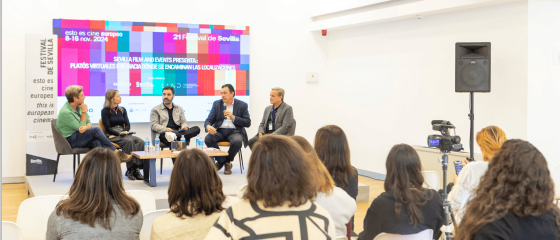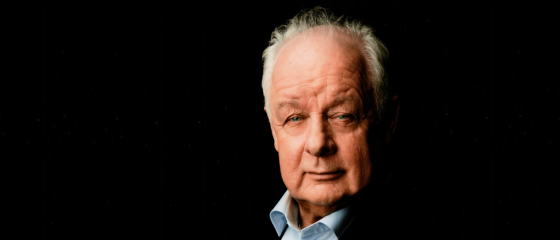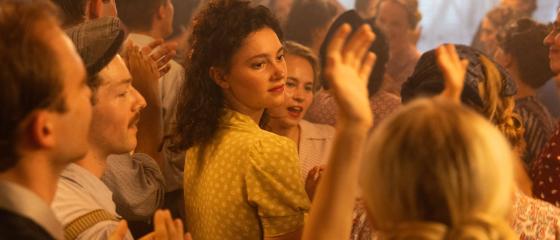
The director from Almeria responsible for titles such as 'Caníbal' and 'El autor' has shared with the media the details of his new film together with the actresses Patricia López Arnaiz and Irene Virgüez along with the members of Vetusta Morla.
The Lope de Vega Theatre is hosting the Seville premiere of the film in a premiere where the band Vetusta Morla will interpret the soundtrack 'La reina de las trincheras' (The Queen of the Trenches).
Seville, 10 November - The director from Almería, Manuel Martín Cuenca (El Ejido, 1964) has presented his new, disturbing work, La hija (The Daughter), which arrives in Seville after passing through the Toronto and San Sebastián festivals. With this film, Martín Cuenca, responsible for titles such as El autor, Caníbal and La flaqueza del bolchevique, abounds in the creation of disturbing atmospheres and in tackling complex themes that pose moral conflicts for the spectator. Based on the encounter between a teenage runaway from a juvenile detention centre and a married couple who are obsessively living with the obsession of not being able to have offspring, The Daughter proposes the absorbing emotional journey of three characters on the edge.
"The production design was particularly difficult, because it meant telling a story through the gestation of a life, the pregnancy of the protagonist. And this physical transformation was also accompanied by the transformation of the environment, the Sierra de Jaén", the filmmaker began explaining in his meeting with the media.
"From a logistical point of view, the film had to be shot in three blocks. This was also a challenge on a creative level, because we had to manage to combine these three characters, follow them without judging them, without defending them, letting their actions speak for themselves. Undoubtedly, it was complicated, but I had two wonderful actresses and an actor who helped me to achieve it", commented on the work of Patricia López Arnáiz and Irene Virgüez, who accompanied the filmmaker during his presentation at the Seville Festival, and that of Javier Gutiérrez.
For his part, Fernando Bovaira, producer of this feature film, added that Manuel Martín Cuenca took an early interest in this script, developed with Alejandro Hernández based on an idea by Félix Vidal. "Manolo was interested in it, which does not mean that it was a commission, because the moment it appeared, the project became a film by Manolo Martín Cuenca. All you have to do is accompany him to give his vision of the story and give him the necessary means. I define it as a dramatic thriller, a complex mixture that needs the director's clear vision".
Martín Cuenca relies on the work of two outstanding actors like Javier Gutiérrez and Patricia López Arnáiz, and Irene Virgüez, a dazzling teenager who is making her debut in the film. Regarding the work of the team of actors, Martín Cuenca underlined the complicity with them. " I really wanted to return with Javier, and I spoke to him about the story while we were promoting El autor (set in Seville). He is a magnificent actor, I always say that he represents the average guy you meet and you give him the keys to your house so that he can water your plants. At the same time he has that ambiguity that makes him capable of reaching many different places with his performance. I came to Patricia (López) through Eva Leira and Yolanda Serrano, the casting directors. A lot of things happened in that audition: there was a wonderful channelling of emotions, an open heart.... And later, after a very long casting process, Irene appeared, and I loved her from the first audition: we were captivated by her innocence, her lack of stridency in her acting, in a very natural way: during the filming I called her my Japanese actress".
Winner of the Goya for Best Actress for Ane, Patricia López Arnáiz has told us about her experience in composing a complex character: "Before shooting, we lived in a bubble for several weeks in which we worked a lot on the characters' pasts. There was improvisation, reflection, creation, in a way we wanted to have a background, a loaded backpack, with which to start shooting". The actress from Mientras dure la guerra and the series La peste highlighted Martín Cuenca's work as a director. "He proposed experiments that led us into situations that helped to shape the character, so that the spectator, when he sees the film, intuits things that are not portrayed". Irene Vigüez, for her part, added to this idea: "We created a relationship between my character and those of Javier and Patricia through games and improvisations".
Lastly, one of the most striking elements of the film is the soundtrack, created by the band Vetusta Morla. One of its members, Guille Galván, explained his role in the project: "It was a huge challenge for us because there had been some previous proposals, but until now we had never seen that we could contribute as much as we did in La hija. We felt we could be part of the creative process. Manolo entrusted us with the request for a soundtrack that didn't play with emotions, that didn't underline the obvious, but that played against the grain and was born from the sounds of the film itself. This was exciting for us, because it was something new for us. The first thing was to build an orchestra with instruments that didn't exist: the engine of a car, the wind, the river, or the sounds of the landscape, an additional character. And with their work, the actresses and actors became, almost, like our singers, directing each passage, each song, and that's where we leaned on. We did a very intuitive job, choosing how we could accompany the moral fall of the characters who try to put an end to an injustice by committing a much worse injustice. And the music helps to understand the characters' positions".
The locations, in the Sierra de Jaén, are fundamental to La hija. In this regard, Manuel Martín Cuenca explained that he always had the Jaén landscape as the setting for the film. "From the beginning, organically, I thought of Jaén as a matter of intuition, of faith. I had been to the colonies when I was a child, and I hadn't been back for 40 years. For a week, I travelled around the territory with the co-writer, Alejandro Hernández, thinking about how we would rewrite the script. Landscape is in the DNA of film and I never write without knowing the place where I imagine the story might take place, I never imagine stories in the abstract. The landscape becomes part of the narrative, and represents the state of mind, the inner psychological portrait, of the characters. For me it is essential to travel to these locations, as I understand cinema: there is nothing more beautiful, it is a privilege to know these environments, cinema is a space of spiritual transformation and these journeys are part of it. I am a craftsman, I feel like a craftsman, in any case the chief craftsman of the craftsmen who make a film".






